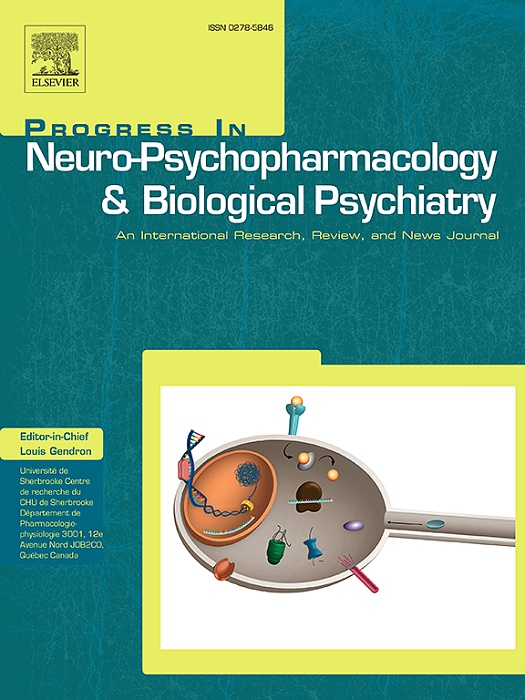探索生理性别对创伤后应激障碍内在连接网络的影响:数据驱动法
IF 5.3
2区 医学
Q1 CLINICAL NEUROLOGY
Progress in Neuro-Psychopharmacology & Biological Psychiatry
Pub Date : 2024-10-22
DOI:10.1016/j.pnpbp.2024.111180
引用次数: 0
摘要
导言:性别作为生物变量(SABV)可能有助于解释创伤后应激障碍(PTSD)症状在遭受创伤的男性和女性中的不同发展和表现。在此,我们研究了 SABV 对创伤后应激障碍相关神经静息态功能连接(rsFC)改变的影响,这些改变发生在三个核心内在连接网络(ICN)中:显著性网络(SN)、中央执行网络(CEN)和默认模式网络(DMN):利用独立成分分析(ICA),我们通过全因子方差分析比较了患有和未患有创伤后应激障碍的男性和女性(n = 47 名患有创伤后应激障碍的女性,n = 34 名患有创伤后应激障碍的男性,n = 36 名健康对照组女性,n = 20 名健康对照组男性)的显著性网络(SN)、中央执行网络(CEN)和默认模式网络(DMN)的rsFC。此外,我们还对临床变量(即创伤后应激障碍和抑郁症状、童年创伤评分)进行了线性回归分析,以确定 SABV 所特有的内在网络连接特征。此外,我们还利用机器学习分类模型,根据内在网络活动模式预测参与者的生理性别和创伤后应激障碍诊断:结果:我们的研究结果显示了基于 SABV 和创伤后应激障碍诊断的不同网络连接模式。与女性创伤后应激障碍患者相比,男性创伤后应激障碍患者的SN内(即SN-岛叶前部)rsFC增加,DMN-顶叶右上/楔回/枕上回rsFC增加。在创伤后应激障碍组和健康对照组的比较中,男性和女性的网络连接模式也存在差异。我们没有观察到相关临床指标与脑区集群之间存在明显的相关性,而这些脑区集群在生理性别的作用下显示出明显的组间差异,从而进一步证实了 SABV 分析可能不会受到这些变量的干扰。此外,机器学习分类模型根据 ICN 激活模式准确预测了新的/未见过的参与者的生理性别和创伤后应激障碍诊断:本研究利用数据驱动方法揭示了 SABV 对创伤后应激障碍相关 ICN 改变的影响,具有开创性意义。我们的发现有助于进一步确定女性和男性创伤后应激障碍的神经生物学标志物,并为与性别相关的不同治疗需求提供指导。本文章由计算机程序翻译,如有差异,请以英文原文为准。
Exploring the impact of biological sex on intrinsic connectivity networks in PTSD: A data-driven approach
Introduction
Sex as a biological variable (SABV) may help to account for the differential development and expression of post-traumatic stress disorder (PTSD) symptoms among trauma-exposed males and females. Here, we investigate the impact of SABV on PTSD-related neural alterations in resting-state functional connectivity (rsFC) within three core intrinsic connectivity networks (ICNs): the salience network (SN), central executive network (CEN), and default mode network (DMN).
Methods
Using an independent component analysis (ICA), we compared rsFC of the SN, CEN, and DMN between males and females, with and without PTSD (n = 47 females with PTSD, n = 34 males with PTSD, n = 36 healthy control females, n = 20 healthy control males) via full factorial ANCOVAs. Additionally, linear regression analyses were conducted with clinical variables (i.e., PTSD and depression symptoms, childhood trauma scores) in order to determine intrinsic network connectivity characteristics specific to SABV. Furthermore, we utilized machine learning classification models to predict the biological sex and PTSD diagnosis of individual participants based on intrinsic network activity patterns.
Results
Our findings revealed differential network connectivity patterns based on SABV and PTSD diagnosis. Males with PTSD exhibited increased intra-SN (i.e., SN-anterior insula) rsFC and increased DMN-right superior parietal lobule/precuneus/superior occipital gyrus rsFC as compared to females with PTSD. There were also differential network connectivity patterns for comparisons between the PTSD and healthy control groups for males and females, separately. We did not observe significant correlations between clinical measures of interest and brain region clusters which displayed significant between group differences as a function of biological sex, thus further reinforcing that SABV analyses are likely not confounded by these variables. Furthermore, machine learning classification models accurately predicted biological sex and PTSD diagnosis among novel/unseen participants based on ICN activation patterns.
Conclusion
This study reveals groundbreaking insights surrounding the impact of SABV on PTSD-related ICN alterations using data-driven methods. Our discoveries contribute to further defining neurobiological markers of PTSD among females and males and may offer guidance for differential sex-related treatment needs.
求助全文
通过发布文献求助,成功后即可免费获取论文全文。
去求助
来源期刊
CiteScore
12.00
自引率
1.80%
发文量
153
审稿时长
56 days
期刊介绍:
Progress in Neuro-Psychopharmacology & Biological Psychiatry is an international and multidisciplinary journal which aims to ensure the rapid publication of authoritative reviews and research papers dealing with experimental and clinical aspects of neuro-psychopharmacology and biological psychiatry. Issues of the journal are regularly devoted wholly in or in part to a topical subject.
Progress in Neuro-Psychopharmacology & Biological Psychiatry does not publish work on the actions of biological extracts unless the pharmacological active molecular substrate and/or specific receptor binding properties of the extract compounds are elucidated.

 求助内容:
求助内容: 应助结果提醒方式:
应助结果提醒方式:


